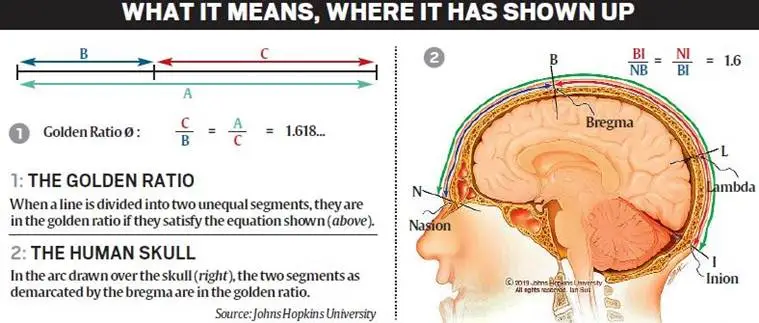- India
- International
The mysterious golden ratio: why is it everywhere, now in human skull?
The golden ratio appears in the work of artists and designers from Da Vinci to Corbusier, and also shows itself in nature in pineapple scales, rose petals and many more places.
 The golden ratio divides a line into two unequal parts as shown. The same ratio shows up in the human skull, when the arc over it is divided at the bregma. (Source: Johns Hopkins University)
The golden ratio divides a line into two unequal parts as shown. The same ratio shows up in the human skull, when the arc over it is divided at the bregma. (Source: Johns Hopkins University)
For centuries, the golden ratio has fascinated all kinds of people, not just mathematicians. Physicists and biologists have studied it, architects and artists have used it, and worshippers have described it as a divine design. And through the centuries, the golden ratio has continued to amaze its diverse fans, frequently cropping up at unexpected places.
The latest such place is the human skull. If we draw an arc across the top of the skull and divide it at a key junction over the brain, the two arc-segments are approximately in the golden ratio. This feature was studied recently by researchers of Johns Hopkins University, US, who have reported their findings in The Journal of Craniofacial Surgery.
Just a ratio, yet special
The golden ratio can be defined in terms of a line, divided into two unequal segments in a way that their lengths meet a simple condition. When the ratio between these two lengths (the longer segment divided by the shorter one) happens to be the same as the ratio between the entire line and the longer segment, then the line is said to be divided in the golden ratio (see illustration).
For this condition to hold good, the ratio needs to be 1.61803… with the digits after the decimal going on forever; the golden ratio is what we call an “irrational number”. It is represented by the Greek letter phi.
Why should such a ratio be considered special? Aesthetic appeal is among the first of many reasons. Architects such as Le Corbusier have consciously proportioned their works to the golden ratio, or close. So have artists such as Salvador Dalí and Leonardo da Vinci, whose fascination with the golden ratio features in the novel The Da Vinci Code and the film based on it.

Interpretations of the golden ratio have not always been objective. Some have related it to their idea of aesthetic beauty in facial proportions, using the golden ratio to describe Audrey Hepburn’s face as perfection, and Marilyn Monroe’s as close.
The fact remains, however, that the golden ratio frequently shows itself in nature, whether directly or indirectly (through its cousins called the Fibonacci numbers). To cite a few examples, the golden ratio appears in the seeds of sunflowers, the scales of pineapples, the arrangement of petals on a rose, DNA structures, the anatomy of the heart — and has now turned up in the human skull.
The newest appearance
In the days before computerised scans became the norm, neurosurgeons would themselves carry out measurements on the skulls of their patients. One such measurement is the distance from the base of the nose (nasion) to the bump at the back of the head (inion).
Measuring this arc in his patients, Dr Rafael J Tamargo of Johns Hopkins observed a trend. At a junction called the bregma, which is the meeting point of two important connective tissue joints, the arc was divided into two sub-arcs that respectively accounted for 61.8% and 38.2% of the total arc length.
Tamargo realised that these fractions were in the golden ratio. “That’s how my interest started,” he said over the phone.
For the new study, Tamargo and colleague Dr Jonathan A Pindrik, his co-author, examined the head CAT scans of 100 patients. Indeed, they found, the two sub-arcs on either side of the bregma are in a ratio that approximates the golden ratio.
Only in humans
For comparison, Tamargo and Pindrik carried out the same measurements in 70 skulls of six other mammals, part of the collection of the Smithsonian Institution National Museum of Natural History in Washington DC. This time, the division was not in the golden ratio of 1.61.
Yet a trend appeared to emerge here too. The closest to the golden ratio was found in the skulls of lions (measured ratio 1.74), followed by tigers (1.77), before deviating further and further for rhesus monkeys (1.86), domestic dogs (1.91), blue monkeys (1.95) and finally eastern cottontail rabbits, in whose skulls the ratio was a distant 2.25.
In the limited sampling, it appeared that the more sophisticated the mammal, the closer the measured ratio was to the golden ratio. It is unclear, the research paper said, why the golden ratio emerges in the human skull and not in those of lower mammals.
The mystery endures
The golden ratio is alternatively called the golden mean and the divine ratio. Its frequent appearances in nature have driven claims that it is the work of a divine design. With its emergence in the human skull, can it fuel further the idea that the ratio has mystical attributes? Tamargo described that as a difficult question to answer.
“I am limiting myself to reporting what I have found. But I think it is unavoidable to wonder why this number appears in nature so frequently,” he said. He described various examples of its appearance, then added: “Some people have said that this ratio may be the signature of God in nature.”
More Explained
EXPRESS OPINION
Apr 25: Latest News
- 01
- 02
- 03
- 04
- 05










































